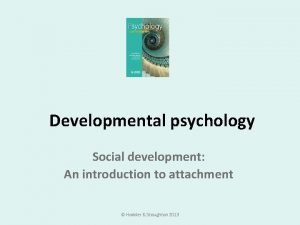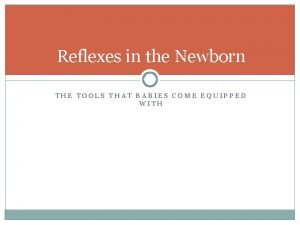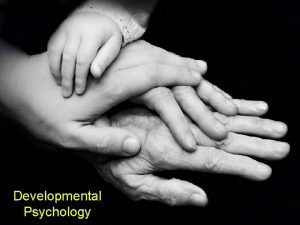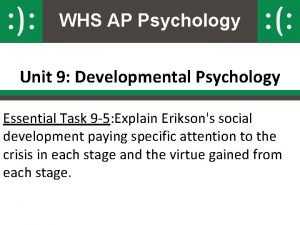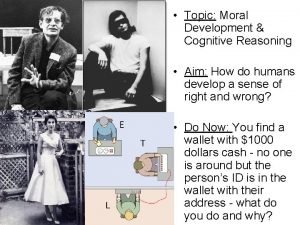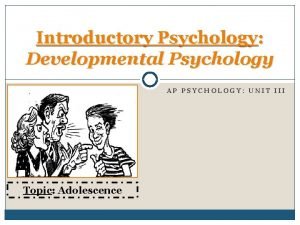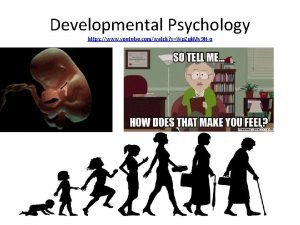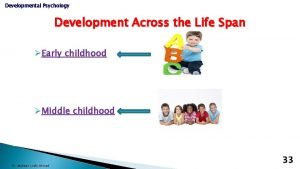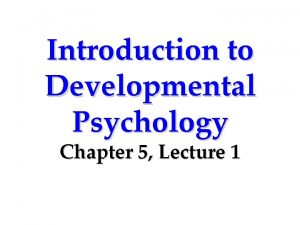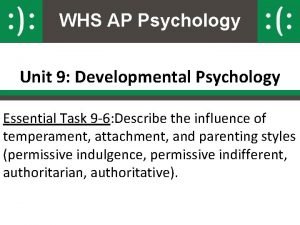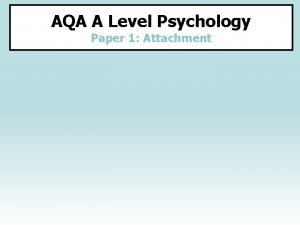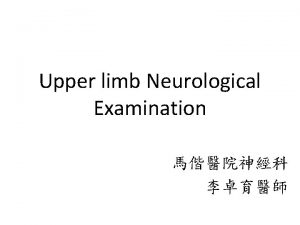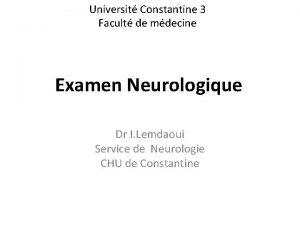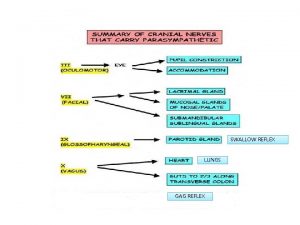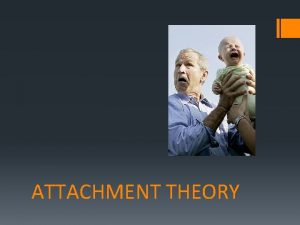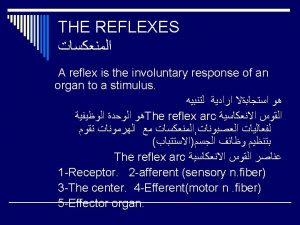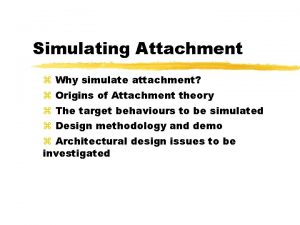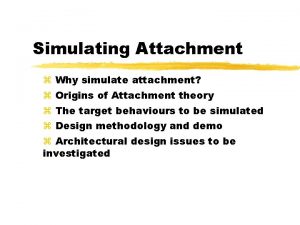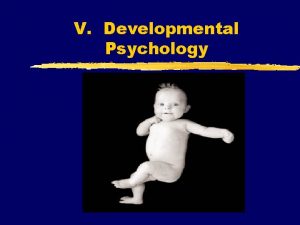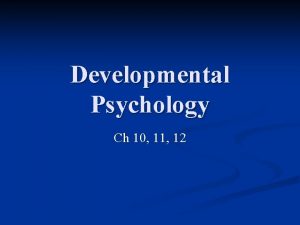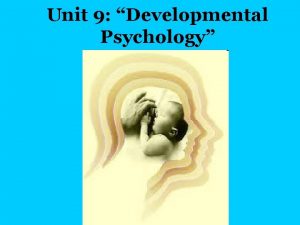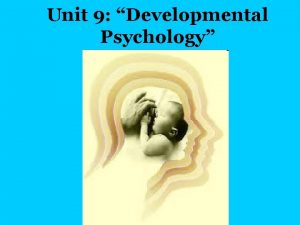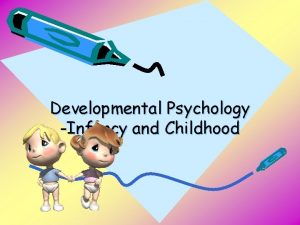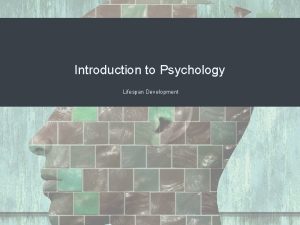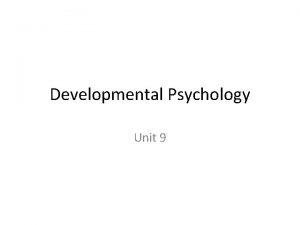Developmental Psychology Infant Reflexes Attachment The Infants World





















- Slides: 21

Developmental Psychology

Infant Reflexes & Attachment

The Infant’s World • Many abilities, tendencies, and characteristics are universal in human beings & are present at birth, or soon thereafter. • Newborns begin life with several motor reflexes, or automatic behaviors that are necessary for survival

Reflexes of the Newborn Baby 1. 2. 3. 4. 5. 6. 7. Rooting Sucking Swallowing Moro or “startle” Babinski Grasp Stepping http: //www. youtube. com/watch? v=h. Diq. ATUYj. X 4

1. ) Rooting Reflex • An infant touched on the cheek or corner of the mouth will turn toward the touch and search for something to suck on.

2. ) Sucking Reflex • An infant will suck on anything suckable, such as a nipple or finger.

3. ) Swallowing Reflex • An infant can swallow, though this reflex is not yet well coordinated with breathing.

4. ) Moro or “Startle” • In response to a loud noise or a physical shock, an infant will throw its arms outward and arch its back. • Also occurs when infant feels as if they’re falling.

5. ) Babinski Reflex 1. 2. • In response to a touch on the bottom of the foot, the infant will splay its toes outward and then curl them in. • In adults, toes just curl in.

6. ) Grasp Reflex • In response to a touch on the palm of the hand, an infant will grasp.

7. ) Stepping Reflex • If held so that the feet just touch the ground, an infant will show “walking” movements, alternating the feet in steps.

Attachment • Emotional attachment is a universal desire or all primates. • Important for health and survival • Allows child to explore world, but return to safe haven if afraid

Contact Comfort • Attachment begins with physical touching and cuddling between infant and parent. • Harlow’s Monkeys • Human children, too, seek contact comfort when they are in an unfamiliar situation, scared, or hurt. http: //www. youtube. com/watch? v=hs. A 5 Sec 6 d. AI

Separation and Security • Once babies are emotionally attached to the mother, separation can be a wrenching experience. • Cry if left in unfamiliar setting or with a stranger. • Show separation anxiety if primary caregiver leaves them. • The Strange Situation http: //www. youtube. com/watch? v=QTsew. Nr. HUHU

Three Categories of Attachment 1. Securely attached 2. Insecurely attached 2 a. ) Avoidance 2 b. ) Anxious or ambivalent (having torn feelings)

1. ) Secure Attachment • Baby cries or protests if the mother leaves the room • Welcomes her back upon return • Happily continues playing

2 a. ) Avoidance • Not caring if the mother leaves the room • Makes little effort to seek contact with her on upon return • Treating stranger about same to mother

2 b. ) Anxious or Ambivalent • Resisting contact with mother at reunion • Protests loudly if she leaves • May cry to be picked up, then demand to be put down

What Causes Insecure Attachment? 1. Abandonment and deprivation in first two years of life 2. Parenting that is abusive, neglectful, or erratic because parent is chronically irresponsible or depressed. 3. Child’s own genetically-influenced temperament 4. Changing, stressful circumstances in the child’s family.

Practice! 1. Melanie is playing happily on a jungle gym at her child-care center when she falls off and scrapes her knee. She runs to her caregiver for a consoling cuddle. Melanie is seeking _____. 2. A baby left in the Strange Situation does not protest when his mother leaves the room, and he seems to ignore her when she returns. What style of attachment is this behavior said to reflect?

How’d You Do? ? 1. Contact comfort 2. Insecure (avoidant)
 Attachment theory bowlby
Attachment theory bowlby Infant reflexes chart
Infant reflexes chart Module 45 developmental issues
Module 45 developmental issues Infant reflexes chart
Infant reflexes chart Neonatal reflexes
Neonatal reflexes Rooting reflex
Rooting reflex Unit 9 developmental psychology
Unit 9 developmental psychology Lawrence kohlberg developmental psychology
Lawrence kohlberg developmental psychology Research methods in developmental psychology
Research methods in developmental psychology What is psychology
What is psychology Adolescence ap psychology
Adolescence ap psychology Devonte is a graduate student in developmental psychology
Devonte is a graduate student in developmental psychology Unit 3 developmental psychology
Unit 3 developmental psychology Ucf psychology major requirements
Ucf psychology major requirements Regression
Regression Characteristics of social development
Characteristics of social development Chapter 5 developmental psychology
Chapter 5 developmental psychology Ap psychology unit 9
Ap psychology unit 9 Jin et al attachment study
Jin et al attachment study Stretch reflexes
Stretch reflexes Reflexes ostéo tendineux
Reflexes ostéo tendineux Gag swallow reflexes
Gag swallow reflexes
